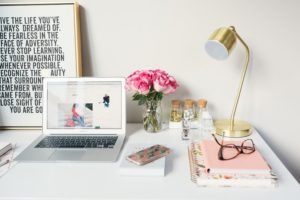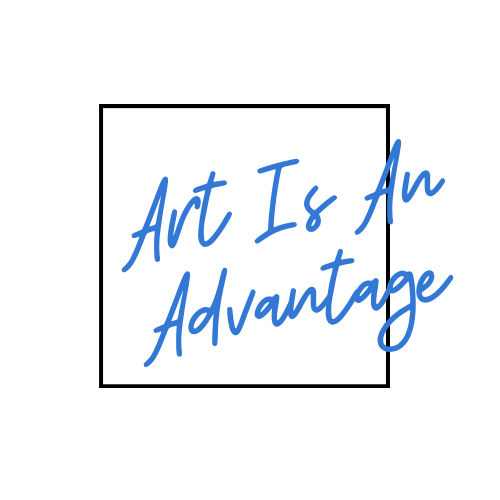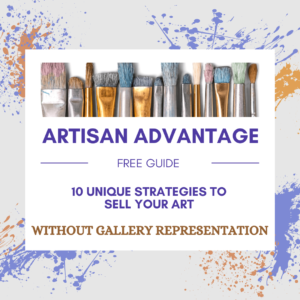by Rebecca Sciullo | Apr 29, 2020 | Blogging, Writing
 If you are trying to produce content regularly for your artist blog, it’s essential to have a productive writing space. You need an area where you are comfortable and able to focus on brainstorming, writing, and editing your posts.
If you are trying to produce content regularly for your artist blog, it’s essential to have a productive writing space. You need an area where you are comfortable and able to focus on brainstorming, writing, and editing your posts.
You may need a place that is separate from your studio. My writing space has been taken over by my daughter, thanks to at-home pandemic learning, so I’ve been relegated to a couch. It’s working, but I’m looking forward to the day I can reclaim my space!
Tips for Finding or Creating the Perfect Writing Space
NY Book Editors offer practical advice like uncluttering your space and adding a little inspiration.
How to foster creativity and inspiration from The Writing Cooperative.
Grammarly put up a post about unconventional writing spaces. You may find that something like this works for you.
The Bottom Line
The best space is the one that you will use. It may take some trial and error, but work to find the place where you are comfortable and able to focus for periods on writing content for your artist blog. The more you write about your art, the easier it will get.
Do you have a writing space that you love? Send me a photo, I’d love to see it.
Interested in starting a blog for your visual art business, visit Artist Blogging 101.
Photo by Arnel Hasanovic on Unsplash
Disclosure: Some of the links in the post above are “affiliate links.” This means if you click on the link and purchase an item from Grammarly I will receive an affiliate commission. Regardless, I only recommend products or services I use personally and believe will add value to my readers.
by Rebecca Sciullo | Apr 27, 2020 | Artist Blogging 101, Learning
The last entry in Artist Blogging 101 reviewed the basic structure of a blog post. Before we get into the details of how and what to post, make sure that you have the appropriate pages set up on your site.
Pages to Consider for Your Artist Blog
Pages contain static content. Your audience can find them by navigating from your menu bar. While you will update them from time to time, they are generally not updated daily, like your posts. On Artisan Advantage, some of the pages include such as About, Resources, and Contact.
Here the pages that you should consider including on your site.
About Page:
This page will help visitors to get to know you. Style and content will vary, but here are some ideas on what to include.
A welcome to visitors. Thank them for visiting your site.
Your biography and artist statement. You could write your biographical information in a more informal style than you would in the case of submitting a bio to an exhibition or entry. Or, you could set up sub-pages for your biography and artist statement.
An invitation to follow you on your social media pages and to sign up for your email newsletter.
Some guidance on how to find your blog posts, in case someone lands on the About page first.
How to contact you. Yes, you will also have a contact page, but it never hurts to include this information on your About page as well.
Here is the About Page that I created for my father.
Gallery Page
While your blog posts will feature your work, you should have one page that directs them to a gallery of your work. There are different options for how to set up your gallery. You can consider using a system like Artwork Archive or you could build your gallery right into your site.
Here is an example of a Gallery page from artist Marla Greenfield.
Here is another way to set up your gallery, from artist Don Lake.
Artist Amy Rice presents her work as Portfolios and Projects.
Contact Me Page
This page is devoted to providing information on how people can contact you. Most blog platforms will give you the option of adding a contact form. I still recommend including an email address and any other contact information that you are comfortable sharing here.
How to Find Page
This page helps people to learn where they can find your work, either in person or online. The content will depend on your situation. Examples of information that you share would be galleries or retail venues that exhibit your work, both online and offline.
Events Page
An events page would list all of the different places that you are presenting or exhibiting in person. Or, considering our current situation, you could add online events such as virtual exhibitions, art talks, or demos if you are doing these things.
Include any place where people can interact with you in real-time.
How to Hire Page
If you do portrait or commission work, you should devote a page that explains how someone can hire you.
Here is an example from artist Mara Carlini.
How to Purchase Page
Similar to a “How to Hire Page” would be a How to purchase your work page. Explain how you transact, ship work, handle returns, etc. The more information that you can provide, the more likely your online visitor will feel comfortable dealing with you.
In the Press or Media Page.
List websites or news outlets where you or your work is featured. Keep track of your articles and add them to this list in a reverse chronological manner as they appear. Don’t be shy about tooting your own horn! These articles also help to establish your credibility with your audience. If there are one or two that are extremely impressive, you may want to feature them on your About page as well.
Publishing Your Pages
Publishing your pages should be a similar process to publishing a post. Don’t be afraid to work through a few drafts before you publish them. Take time to edit and proof before you launch, but remember, you can always update them as needed.
This week, take time to work on your pages. For more content from Artist Blogging 101, go here. If you’d like some help with your artist blog, visit my Artist Blogging Services page.
Do you have a unique page that is working well for your artist website and blog? I’d love to see it. Feel free to send a note and a link to becky@artisan-advantage.com.
by Rebecca Sciullo | Apr 20, 2020 | Artist Blogging 101
Once you understand how your blog is set up and have established your categories, it’s time to start posting. Technically you could upload an image of your work and leave it at that, but a better practice is to put together a well-constructed entry every time you post. This post focuses on how to structure your artist blog posts.
How to Structure Your Blog Posts
Each blog post should contain the following:
Title. Use a strong title that will interest your reader.
Introductory paragraph. Provide a clear introduction prefacing what the post is about with an introductory paragraph.
Headings. In this post, “How to Structure Your Blog Posts” above is a heading. Headings help to capture your audience’s attention. Many readers will quickly skim the headings before deciding whether or not to read more.
Body The body is where you share the bulk of your information. Use shorter paragraphs. Use your authentic voice when you write.
Professional image. Use clear and appropriately cropped images. In addition to your work, incorporate pictures of yourself at work, your studio, or anything else that might be interesting to people who follow your work.
Call to action. At the end, you should ask your reader to take some action. You might ask them to visit your online gallery where you share more images in a collection, sign up for your newsletter, or follow you on Facebook. While you have their attention, make sure you find a way to keep them engaged.
The Importance of Your Writing
For an artist, your work is going to be the focal point of your blog posting, but don’t assume that the accompanying text is not important. Your authentic writing can be a great support to your visual media and should entice your readers to learn more about you and your work. We’ll talk about this more in coming posts.
Stay tuned to Artist Blogging 101 for more tips on writing posts for your artist blog. If you missed earlier posts, start here.
Join the Artisan Advantage newsletter for regular updates.
by Rebecca Sciullo | Apr 16, 2020 | Artist Blogging 101, Learning
What You Need to Know About Your Artist Blog Categories
Your blog posts have to have a Category – a word or short phrase that describes your post topic.
For instance, on Artisan Advantage, my Categories include things like Artist Blogging 101, Resources, and Events. You can see a full list of my Categories in the right-hand sidebar of my website.
Make a list of Categories that you think makes sense for your blog. Try to avoid long phrases, and try to limit the number of Categories as this will look neater in your sidebar and be easier to manage.
Most blogging platforms will have a default Category such as Uncategorized. Remove or rename this one. General Might be a better term for posts that don’t fit within any of your main categories.
Here are some common Category names used on artist blogs.
New Work
Events
Workshops
Learning
Demonstrations
If you work in various media, you could have a category for each type. If you paint different types of subject matter, you could have a category for every kind of subject that you paint.
Tips on Setting Up Categories
Set up your Categories before you start posting so that they are ready to go. You can always add or edit them as you go.
Be thoughtful about your Categories. Category names should be logical and not made-up or clever names. They are essential navigation links, so treat them accordingly.
Try to avoid long phrases. Most Categories are one to four words.
Try to limit the number of Categories as this will look neater in your sidebar and be easier to manage.
For more information on how to start and maintain an artist blog, follow along with Artist Blogging 101
For help with your artist blog, visit my Artist Blogging Services page.
by Rebecca Sciullo | Apr 14, 2020 | Learning, Resources
Here in Pennsylvania, where I live, we are five weeks into our “stay at home” order. In my household, we’ve been figuring things out as we go. Emotions have run the gamut from fear to frustration to gratitude. Things that have sustained me include my faith, family, neighbors, (aka social distancing) and staying busy.
Where I’m Focusing During COVID-19
After the initial shock of this situation, I have been attempting to focus my business in a few areas.
– Finishing projects that were long overdue.
– Making changes to my business plan for the future.
– Maintaining relationships.
I have spent some time learning and watching webinars specifically focused on how businesses can manage through this crisis and thought I would share some things that I learned with you from them:
Business Survival Takeaways
– Look for good news. Focusing on the endless barrage of negative news will not help your mindset for business. It’s okay to check in once a day but avoid overexposure.
– You have a choice. You can respond or react to the situation. Choose “respond”.
– Acknowledge reality. Own it. Solve it. Do it.
– Give yourself moments to breathe.
– Over-communicate.
– Adjust your plans and act accordingly.
Watch this webinar.
For visual artists, I recommend watching this webinar offered by Artwork Archive – Strategies for Running an Art Business During COVID-19. It is full of ideas and resources to help you adjust your business to this situation.
This 30-minute webinar will provide you with the tools, strategy and resources to transition your art career online and help you decide what areas you can control during these unprecedented and difficult times.
One last word. It is normal to have a “bad day”. I have experienced my fair share during this experience. Stay strong! We will get through this.
*Legal Disclaimer. The information contained in this webinar, in Artwork Archive materials and on the Artwork Archive or affiliated websites is provided for informational purposes only, and should not be construed as legal advice on any subject matter. You should not act or refrain from acting on the basis of any content included in this webinar without seeking legal or other professional advice.
 If you are trying to produce content regularly for your artist blog, it’s essential to have a productive writing space. You need an area where you are comfortable and able to focus on brainstorming, writing, and editing your posts.
If you are trying to produce content regularly for your artist blog, it’s essential to have a productive writing space. You need an area where you are comfortable and able to focus on brainstorming, writing, and editing your posts.
